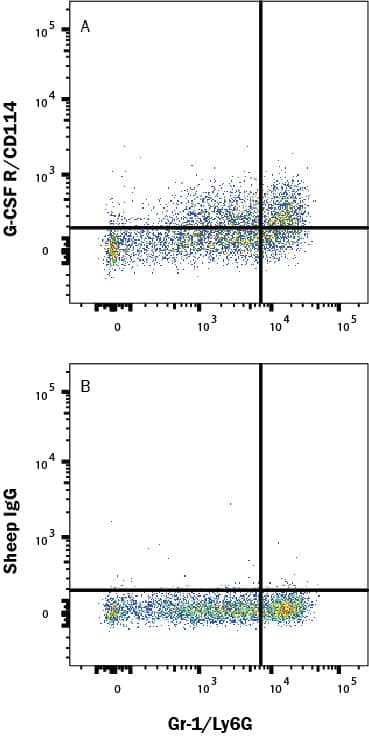Mouse G-CSFR/CD114 APC-conjugated Antibody
R&D Systems, part of Bio-Techne | Catalog # FAB6039A


Key Product Details
Species Reactivity
Validated:
Mouse
Cited:
Mouse
Applications
Validated:
Flow Cytometry
Cited:
Flow Cytometry, Immunohistochemistry
Label
Allophycocyanin (Excitation = 620-650 nm, Emission = 660-670 nm)
Antibody Source
Polyclonal Sheep IgG
Product Specifications
Immunogen
Mouse myeloma cell line NS0-derived recombinant mouse G‑CSF R/CD114
Cys26-Asp626
Accession # P40223
Cys26-Asp626
Accession # P40223
Specificity
Detects mouse G‑CSF R/CD114 in direct ELISAs and Western blots. In direct ELISAs, less than 1% cross-reactivity with recombinant human GM-CSF R alpha and recombinant mouse GM-CSF R alpha is observed.
Clonality
Polyclonal
Host
Sheep
Isotype
IgG
Scientific Data Images for Mouse G-CSFR/CD114 APC-conjugated Antibody
Detection of G‑CSF R/CD114 in Mouse Bone Marrow by Flow Cytometry.
Mouse bone marrow cells were stained with Rat Anti-Mouse Gr-1/Ly-6G PE-conjugated Monoclonal Antibody (FAB1037P) and either (A) Sheep Anti-Mouse G-CSF R/CD114 APC-conjugated Antigen Affinity-purified Polyclonal Antibody (Catalog # FAB6039A) or (B) Normal Sheep IgG Allophycocyanin Control (IC016A). Staining was performed using our Staining Membrane-associated Proteins protocol.Applications for Mouse G-CSFR/CD114 APC-conjugated Antibody
Application
Recommended Usage
Flow Cytometry
10 µL/106 cells
Sample: Mouse bone marrow cells
Sample: Mouse bone marrow cells
Formulation, Preparation, and Storage
Purification
Antigen Affinity-purified
Formulation
Supplied in a saline solution containing BSA and Sodium Azide.
Shipping
The product is shipped with polar packs. Upon receipt, store it immediately at the temperature recommended below.
Stability & Storage
Protect from light. Do not freeze.
- 12 months from date of receipt, 2 to 8 °C as supplied.
Background: G-CSFR/CD114
References
- Ward, A.C. (2007) Front. Biosci. 12:608.
- Layton, J.E. and N.E. Hall (2006) Front. Biosci. 11:3181.
- Mitsui, T. et al. (2003) Blood 101:2990.
- Nicola, N.A. in Cytokine Reference, 2001, Oppenheim, J.J. and M. Feldmann, eds. Academic Press p.1935.
Long Name
Granulocyte Colony Stimulating Factor Receptor
Alternate Names
CD114, CSF3R, Csfgr, G-CSF R, GCSFR
Gene Symbol
CSF3R
UniProt
Additional G-CSFR/CD114 Products
Product Documents for Mouse G-CSFR/CD114 APC-conjugated Antibody
Product Specific Notices for Mouse G-CSFR/CD114 APC-conjugated Antibody
For research use only
